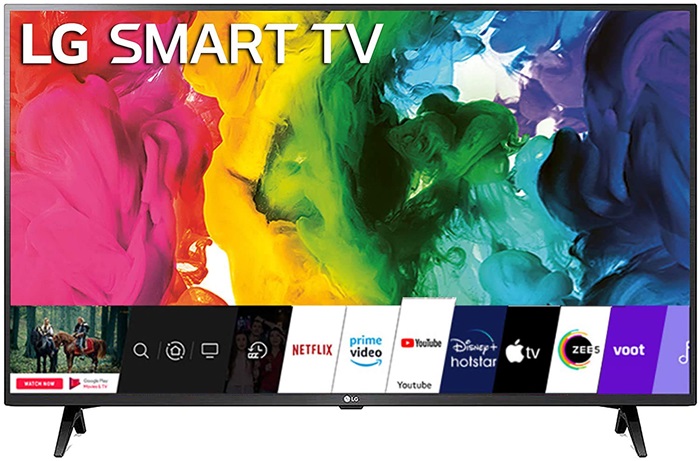Several possible causes can cause color problems to your LG smart TV. Often generalized as “Blue Tint or Color Bleeding” it’s usually a result of the TV’s age, picture settings, damaged cables, and even image burning.
However, before you decide on taking it to an LG technician or even looking for a warranty claim, it’s often advised you explore some troubleshooting measures especially if you want to use the TV soon and can’t afford the time it might spend with a technician. Before we get into specific troubleshooting procedures, let’s first discuss some possible causes.

LG Smart TV Color Problems: Possible Causes
Multiple issues may be responsible for color problems on an LG smart TV. The good thing is that these problems can easily be solved without necessarily needing the expertise of an LG TV technician.
-
Incorrect TV Settings
Most of the time, your TV is only affected by a minor issue caused by your picture settings. Some picture settings don’t work well with some types of video content such, it may appear that you’re having issues with your picture quality when you continue with those settings.
-
Poor Signal Quality
In some cases, your issue may not be related to an actual TV setting, rather, it will be a result of your cable box receiving a poor signal, or your internet not allowing you the proper bandwidth to stream properly. In any of these instances, you may experience a blurred picture or outright black-and-white picture quality.
-
Faulty Connecting Cable
A faulty HDMI or Optical cable can cause color problems for your TV. In this case, you may notice pixelated videos, and sometimes, even the audio having problems. It often happens when your cable becomes worn out and you get to notice some wear out with the device managing to work when you tilt it in a specific direction.
-
Image Retention/Burning
This situation occurs when you leave a static image on your screen for an extended period. Often associated with power issues, it can cause permanent color problems to the screen.
Unfortunately, there’s no way to solve this unless you get another set of LEDs for the TVs which in most cases, is like getting a new one. However, you can prevent this by turning off your TV when it’s not in use, especially when it’s displaying a signal error code and you’re not ready to look into it.
-
Faulty TV Components
A faulty component such as the main board, backlights, or T-CON board can cause color problems. If this is the cause of your problem, then none of the solutions discussed in the second section will be of any help, and you may need to consult customer support.
LG Smart TV Color Problems: How to Fix
If you’re having color problems with your TV, here are some simple troubleshooting measures you can carry out without doing something that may void your warranty if it ever comes to contacting customer support for warranty claims.
-
Change Input Settings
This is often the solution when you’re having a problem with one of your connecting sources such that it’s the only one giving the color problems. For example, if you notice color issues when connected with an HDMI cable, you may try streaming directly or using an optical cable to see if it solves the issue.
To change the input settings on your TV, simply press the Input button on the remote, and all available input will appear on your screen. Use the arrow buttons to navigate the input methods and press enter to select a new one.
-
Run a Pixel Refresh
A pixel refresh is a feature available on all LG OLED TVs, and it can help to reduce image retention and burn-in. It’s quite effective when your specific coloring issue is the “Blue Tint.” All you need do is your press the home button on the remote control, and navigate through Settings >> All Settings >> General >> OLED Care >> Pixel Refresher >> Start Now.
The pixel refresh process will take about an hour to complete. During this time, the TV will turn off and on several times. Do not turn off the TV or unplug it while the pixel refresh process is running. While that’s the case, if you’re not using the specific model of LG Smart TV that supports a pixel refresh, you may try other options to have your issue solved.
-
Power Cycle the TV
This is usually one of the general troubleshooting procedures you can implement when there’s an issue with your LG TV. If power issues or temporary settings cause your color problem, a simple power cycle can help give a quick fix. All you need do is unplug the device from the power socket, wait for about 5 minutes, and plug it back in.
-
Replace Damaged Cables
If you can confirm that the problem is from a defective cable, you’ll want to get a replacement to get things running smoothly again. First, you want to explore other input options to confirm if the color problem is only observed with a particular option. If yes, then proceed to change the cable.
-
Factory Reset the TV
This in any situation should always be your last resort, at least before you contact a professional TV repair man. There are times when you unknowingly make some wrong settings and the result will appear as if your TV is having a color problem. If this is your case, only a factory reset will do. You can follow the step-by-step guide below to perform a factory reset for your LG smart TV.
- Press the home button on your remote control
- Navigate though Settings >> All Settings >> General >> Reset to Initial Settings
- Select Reset and enter your TV’s password if prompted, then Confirm to execute.